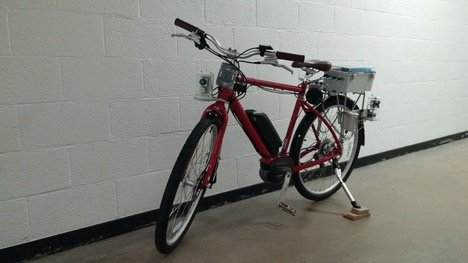A Smart Bicycle that Looks Out for Itself
A smart bicycle has been developed which has sensors to automatically monitor the trajectories of nearby vehicles on the road and alert nearby motorists to the presence of the bicycle, in the event of danger of a collision. Over 48,000 bicyclist injuries and approximately 700 bicyclist fatalities due to crashes with cars are reported annually. The technology on the new bicycle addresses over 80% of the scenarios that lead to these crashes. In addition, a unique black-box recorder on the bicycle documents all important vehicle-bicycle interactions for potential future analysis.
Challenges: Protecting a bicycle from potential car-bicycle crashes requires addressing a number of difficult challenges:
- Only inexpensive sensors can be utilized on the bicycle. Sensors on autonomous cars typically cost many thousands, or even tens of thousands of dollars, and utilize more electrical and computational power. The system developed in this project, on the other hand, is aimed at a market price below $500 and is suitable for a cost-sensitive bicyclist.
- Complex traffic scenarios: The sensors and estimation algorithms on the bicycle need to track trajectories of vehicles on local urban roads where traffic scenarios are more complex than on highways. Riding on local roads involves traffic intersections with many left turning, right turning and cross-traffic vehicles, all of which need to be tracked.
- The collision prevention system needs to be useful on today’s roads. It cannot rely on all cars being autonomous, all cars having wireless connectivity, or other futuristic assumptions which may take many years/ decades to bear fruit.
Technology: This talk will describe how the developed smart bicycle addresses all of the above challenges and functions effectively on today’s roads. The instrumentation on the bicycle includes a single-beam laser sensor, a custom triad sonar unit and a low-density LiDAR sensor. Unique solutions include active rotational control of the single-beam laser sensor to continuously track moving cars behind the bicycle, algorithms to reliably identify vehicles from other objects, and novel estimation algorithms to accurately track lateral and longitudinal positions of cars. On-board speakers are used to create a custom audio “horn” to alert car drivers to the presence of the bicycle. The audio alert presentation is designed to minimize the trade-offs between low reaction time and unnecessarily intrusive disturbances to the bicycle rider and to nearby motorists. The talk will include many videos of the bicycle’s performance under both controlled tests as well as real-world riding on urban roads.
Field Operational Test: The project also includes an intensive 3-month field operational test in collaboration with an industrial partner to evaluate the effectiveness of the developed technology on today’s roads. The field operational test which will begin in October 2019 will involve 10 bicyclist volunteers with significant daily urban commutes and extensive analysis of bicycle data recorded during their commute in real-world traffic conditions.
